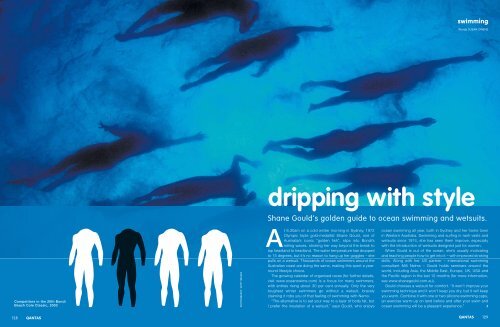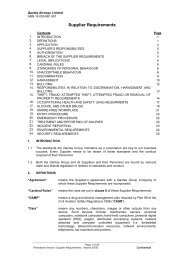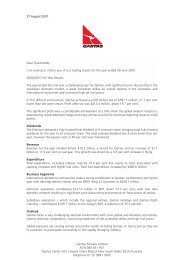You also want an ePaper? Increase the reach of your titles
YUMPU automatically turns print PDFs into web optimized ePapers that Google loves.
IMAGES<br />
GETTY<br />
Competitors in the 20th Bondi<br />
Beach Cole Classic, 2003 PHOTOGRAPHY:<br />
swimming<br />
Words SUSAN OWENS<br />
<strong>dripping</strong> <strong>with</strong> <strong>style</strong><br />
Shane Gould’s golden guide to ocean swimming and wetsuits.<br />
At 6.30am on a cold winter morning in Sydney, 1972<br />
Olympic triple gold-medallist Shane Gould, one of<br />
Australia’s iconic “golden fish”, slips into Bondi’s<br />
rolling waves, stroking her way beyond the break to<br />
lap headland to headland. The water temperature has dropped<br />
to 15 degrees, but it’s no reason to hang up her goggles – she<br />
pulls on a wetsuit. Thousands of ocean swimmers around the<br />
Australian coast are doing the same, making this sport a yearround<br />
life<strong>style</strong> choice.<br />
The growing calendar of organised races (for further details,<br />
visit www.oceanswims.com) is a focus for many swimmers,<br />
<strong>with</strong> entries rising about 30 per cent annually. Only the very<br />
toughest winter swimmers go <strong>with</strong>out a wetsuit, bravely<br />
claiming it robs you of that feeling of swimming <strong>with</strong> Nemo.<br />
“The alternative is to eat your way to a layer of body fat, but<br />
I prefer the insulation of a wetsuit,” says Gould, who enjoys<br />
ocean swimming all year, both in Sydney and her home town<br />
in Western Australia. Swimming and surfing in rash vests and<br />
wetsuits since 1974, she has seen them improve, especially<br />
<strong>with</strong> the introduction of wetsuits designed just for women.<br />
When Gould is out of the ocean, she’s usually motivating<br />
and teaching people how to get into it – <strong>with</strong> improved stroking<br />
skills. Along <strong>with</strong> her US partner – international swimming<br />
consultant Milt Nelms – Gould holds seminars around the<br />
world, including Asia, the Middle East, Europe, UK, USA and<br />
the Pacific region in the last 12 months (for more information,<br />
see www.shanegould.com.au).<br />
Gould chooses a wetsuit for comfort. “It won’t improve your<br />
swimming technique and it won’t keep you dry, but it will keep<br />
you warm. Combine it <strong>with</strong> one or two silicone swimming caps,<br />
an exercise warm-up on land before and after your swim and<br />
ocean swimming will be a pleasant experience.” <br />
128 QANTAS QANTAS<br />
129
swimming<br />
Shane Gould<br />
buying and using wetsuits: a dry run<br />
“When you buy a wetsuit, make sure it’s designed for swimming,<br />
not diving or surfing,” Gould says. “The popularity of triathlons<br />
has improved wetsuit design and those reviewed here are<br />
specifically for swimming. It should have flexibility built into the<br />
shoulders and under the arms. Unlike a surfer’s wetsuit, it’s a<br />
‘second skin’, smooth on the outside to minimise water<br />
resistance and offer flotation assistance.<br />
“The colder the water, the thicker the wetsuit. Surfers call<br />
a long arm and leg wetsuit a ‘steamer’ for good reason. Thicker<br />
wetsuits, at 4mm, can constrict arm strokes. That’s OK for 20-<br />
30 minutes, but it makes a longer swim hard work. Even the<br />
best-fitting wetsuit can cause a rash around the neckline<br />
armpits and crotch – but don’t use vaseline as it will perish<br />
the neoprene rubber. Lanolin is great or choose a lanolinbased<br />
nappy rash cream.<br />
“Know the water temperature, consider how long you plan<br />
to be in it and choose the wetsuit thickness accordingly. Try<br />
different makes. Women shouldn’t use a wetsuit designed for<br />
men. It needs to be skintight as it will loosen a little over time.<br />
You need freedom of shoulder movement and to be able to<br />
breathe and bend your knees and elbows. If you’ve never worn<br />
a wetsuit before, it may feel claustrophobic. Sleeveless suits<br />
are an alternative, but they don’t offer all-round warmth.<br />
“Roll the wetsuit down inside-out halfway to put it on. Don’t<br />
punch it <strong>with</strong> your fingernails. A plastic bag over your feet can<br />
help get it on over heels and ankles. Once it is on, blow into<br />
the neck area and the suit will fill <strong>with</strong> air and sit better on your<br />
skin. A friend can do the same for the arms.<br />
“When you leave the ocean, put salty wetsuits and towels in<br />
a plastic box in your car (to avoid rust). Rinse the wetsuit in<br />
fresh water and hang it inside-out in the shade.” <br />
130 QANTAS<br />
OCEAN SWIMMING<br />
the goulden rules<br />
1<br />
2<br />
3<br />
4<br />
5<br />
6<br />
7<br />
8<br />
9<br />
10<br />
Swim like you are walking, coordinating four<br />
limbs <strong>with</strong> the body, keeping the base rhythm.<br />
Keep energy in your body, but don’t be tense<br />
or totally relaxed.<br />
Swing your arms in curved lines. Take the<br />
“corners” out of your stroke. The swing takes<br />
you forward and connects to body rotation.<br />
Be patient <strong>with</strong> the water, don’t grab at it. Use<br />
the whole arm to get a hold of the water, not<br />
just the hand.<br />
Look down, but check your direction every 10<br />
or so strokes.<br />
Sighting: take a quick look at the top of a swell<br />
during one stroke and get horizontal again<br />
quickly. If you don’t see clearly ahead, wait<br />
until you regain your rhythm and balance,<br />
which may take three to six strokes, then look<br />
again. The less you lift your head, the more<br />
energy you conserve.<br />
Breathe every three strokes to keep rhythm.<br />
Exhale in the water just before you roll for air.<br />
If you get tired – even after 30m – stop and rest<br />
for three to five breaths, then continue.<br />
Balance the energy throughout your body,<br />
don’t just power through your shoulders.<br />
In choppy water or bubbly white water take<br />
shorter strokes – drop your arms in deeper by<br />
putting more energy in your torso.<br />
PHOTOGRAPHY: TINA LOPPACHER
swimming<br />
MARINE LIFE<br />
In her Margaret River, WA, home town, Shane swims <strong>with</strong> the<br />
Prevelly Penguins. “Sometimes the ocean is so wild and cold in<br />
a nor-west winter storm, we just do a tea-bag swim [dip in and<br />
out] then sit around drinking hot coffee or chocolate. I have the<br />
rank of Adelie penguin [the smallest Antarctic penguin]. On the<br />
winter solstice [June 21] the Penguins swim through a bucket of<br />
ice thrown into the sea, go out 25m then come back for a<br />
seafood breakfast. We all get together on Clean Up Australia<br />
Day and clean the beach at Prevelly. On the 1km ocean swim<br />
at Prevelly just after New Year’s Eve, the Penguins join other<br />
ocean swimmers. Many ocean races support local surf clubs,<br />
which mostly have volunteer lifesavers patrolling beaches.”<br />
big dip tips<br />
“Always swim <strong>with</strong> someone close to your speed, and<br />
never swim alone,” Gould says. “Sit, listen and wait before<br />
a swim. Observe conditions for five to 10 minutes. Look for<br />
rips, currents, wave size and wind direction. Tides can affect<br />
conditions. Decide if your skill matches the situation. Plan a<br />
place to get in and a place to get back out.<br />
“Drink water before and after swimming. You lose a lot of<br />
fluid making heat, energy and sweating – even in cold water.<br />
When you first dive into cold water it can take your breath<br />
away. Exhale and inhale consciously until you adapt to the cold.<br />
This may take 15-60 seconds, depending on the temperature.<br />
Focus on your exhale, even while you swim, to blow off carbon<br />
dioxide. If you feel dizzy or get a stitch when you swim you<br />
have probably inhaled more than you’ve exhaled.<br />
“Mix speeds as you swim. It’s easy to get into a one-speed<br />
groove, but ocean conditions and races may require some fast<br />
swimming at the start, to overtake a slower swimmer, or trying<br />
to swim onto that winning wave.<br />
“Warm up as quickly as you can afterwards. When you begin<br />
swimming in winter, if it takes a couple of hours to warm up, the<br />
bad memory will act as a mental deterrent next time. A warm<br />
(not hot) shower is best. At least peel off the wetsuit and get<br />
dry immediately – those few minutes of cold air on damp skin<br />
is the worst part. Have plenty of warm clothes handy including<br />
a windproof jacket, fleecy top and pants. Pull on warm socks<br />
and shoes. Drink fluids at body temperature until you stop<br />
shivering. Keep moving – walk for 10-15 minutes.” <br />
132 QANTAS<br />
SUITS HER<br />
Shane Gould rates the<br />
new wave of wetsuits.<br />
Living 4<br />
www.living4com.au<br />
“Neoprene suits <strong>with</strong> a large choice<br />
of sizing, including suits specifically<br />
for women. The suit is softer and<br />
there’s less neck and armpit<br />
rashing. It felt like a second skin,<br />
but I needed to take more care<br />
putting it on.” Bullet (pictured), $600.<br />
Orca<br />
www.orca.com<br />
Orca claims its wetsuits are the<br />
fastest in the world, <strong>with</strong> the<br />
neoprene fabric offering supreme<br />
buoyancy and shoulder flexibility<br />
while minimising drag. Popular <strong>with</strong><br />
athletes for whom speed is a high<br />
priority. Apex (pictured), $899.<br />
Ironman<br />
www.ironmanwetsuits.com<br />
“Ironman has a suit especially<br />
designed for women. It is functional<br />
and warm. It’s made <strong>with</strong> triathletes<br />
in mind. It was a little stiff for my<br />
first two swims, but I eased into it<br />
and it became comfortable by the<br />
third swim.” Stealth (pictured), $699.<br />
Radiator<br />
www.radiatoroz.com<br />
“This design allowed me to stay in<br />
the water for over 20 minutes. The<br />
suits are made in four layers, <strong>with</strong><br />
a nylon outer skin <strong>with</strong> a titanium<br />
coating and an inner ‘slipskin’<br />
lining. At 1.5mm they’re lighter than<br />
most.” Radiator 1.5 (pictured), $423.

















